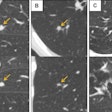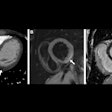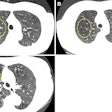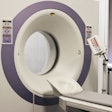A novel workflow involving CT images could result in major benefits for patients who need urgent palliative radiation treatments, according to a presentation at the American Society for Radiation Oncology (ASTRO) meeting in San Diego.
Radiation therapist Melissa O'Neil, of the London Health Sciences Centre in Ontario, Canada, presented her group's findings that using previously taken diagnostic CT scans in place of standard CT simulation scans reduced the time some people waited for treatments from nearly five hours to under 30 minutes.
"When treatment can begin more quickly, patients can have their symptoms relieved faster. Using existing scans can also reduce costs and opens time slots in the clinic’s schedule for us to see and help more patients,” O'Neil said.
Palliative radiation therapy is used to relieve symptoms in patients whose cancers cannot be cured. Often, it is prescribed when tumors are causing the patient pain, neurologic symptoms, or respiratory problems.
Under current standards, patients undergo a CT simulation scan before they can receive treatment. These scans generate 3D images that are used by the patient’s care team to create a custom radiation treatment plan. The process usually takes several hours, O'Neil noted.
Yet many of these patients have undergone recent diagnostic CT scans performed in medical imaging departments outside of the cancer center as a part of routine follow-up or other care, she said. Thus, O’Neil and colleagues investigated whether using these existing CT scans to plan treatment ahead of a patient’s arrival could reduce their time at the cancer center while still enabling appropriate care.
They enrolled 33 patients between June 2022 and April 2023 who needed palliative radiation for tumors and split them into groups evaluated using either existing CT scans or new CT simulation scans. The researchers measured how much time each patient spent at the cancer center on the day of treatment, from the time of their appointment to completion of treatment delivery.
According to the findings, patients in the standard treatment planning group spent nearly five hours (4.8 ± 1.1 hours), on average, at the cancer center, compared to just under half an hour for those not receiving CT simulation scans (0.4 ± 0.1 hours).
In addition, all treatment plans in both arms subsequently were delivered successfully, O'Neil noted.
"With this new workflow, the planning is all done before the patient arrives. So, when the patient comes to the center, they’re in and out. That’s a significant reduction in time burden," she said.
While the results are promising, O'Neil noted that reusing CT scans is not appropriate for all types of cancers or patients. Using existing CT scans to plan treatment for brain tumors is not appropriate, for instance, since they do not require a patient’s head to be immobilized.
"But they are appropriate for patients who need simple palliative radiation for pain control and symptom management," O'Neil concluded.



















